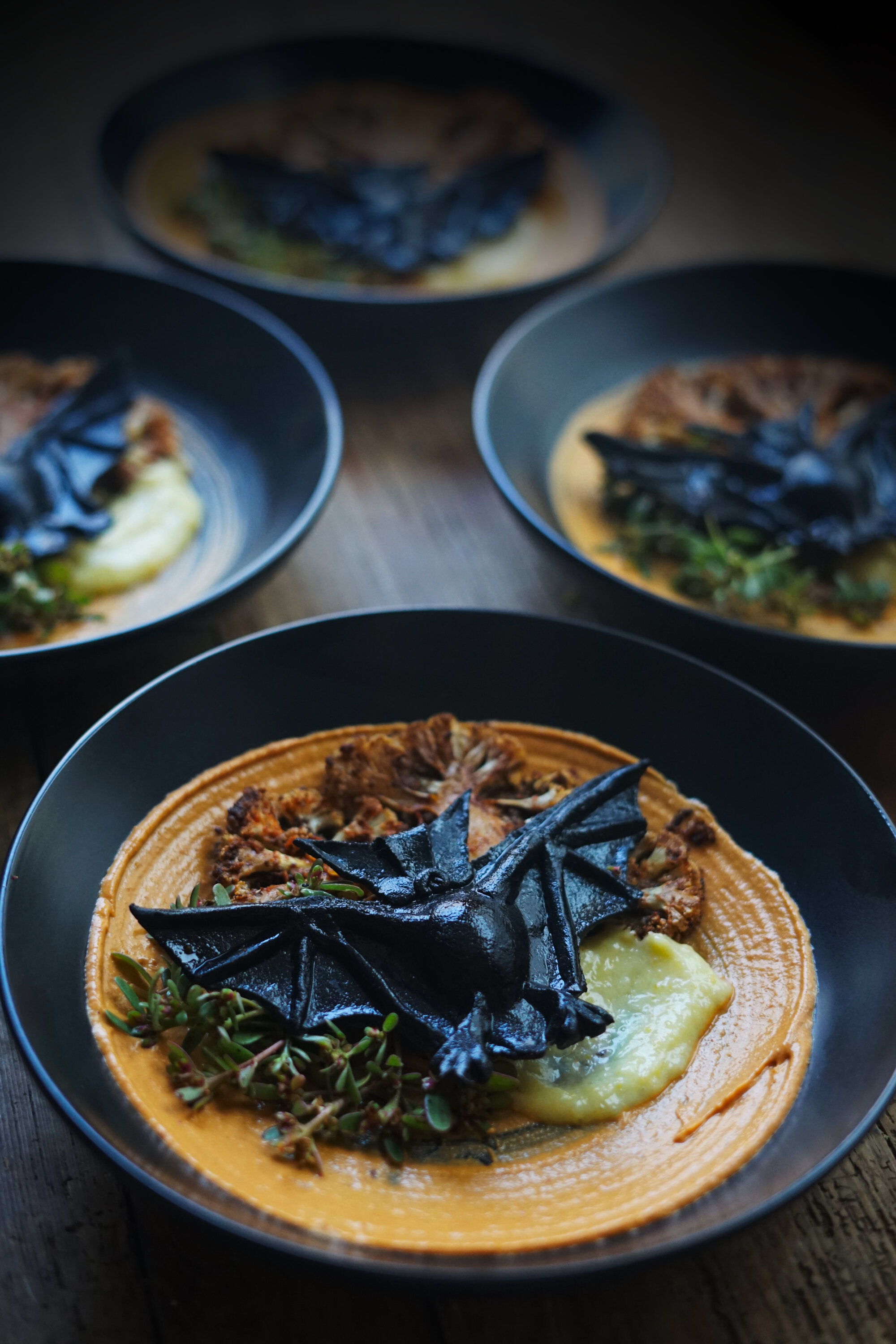For The Love Of Bats: Gluten-Free Pasta With Purslane and Sunset Roasted Cauliflower (Plant Based)
New to foraging? Learn more about ethical and safe foraging (plus how to get started) here!
Imagine you’re all snuggled up in a heavy blanket laying next to me on a balcony in the woods. You’re filled with a strange content anticipation as we watch the sky fade from its warm oranges into dusk. Then, a dark dash like a nearby shooting star crosses your vision. Then another. The bats are coming out, and we are here to both witness and celebrate that! A distant flap of leathery wings, the bats grow in numbers, like the soft threads stitching the shadows of silhouetted trees together, then dissolving back into the air. If you listen closely, you’ll hear a rustle of leathery wings or even their high-pitched calls. Their blurred outlines are as soft as dusk itself.
Bats may be the stuff of horror films and scary seasonal decorations, but they are a keystone species here in the Pacific Northwest and their presence completely changes our ecosystems, whether we realize it or not! It’s a shame that the prevalence of these nocturnal mammals in horror films has convinced a good portion of the population that bats are things to be feared, rabid with the desire for human flesh. Propaganda, I say! There are indeed vampire bats in some parts of the world, but here in the Pacific Northwest, our bats are small insectivores with a vital role to play in our ecosystem!
If you’ve ever been annoyed by mosquitos or other insects, you’d be a lot more annoyed without the presence of bats. According to The Northwest Natural Resource Group,
“a single little brown myotis, a common resident in PNW forests, can consume 1,000 mosquito-sized insects in one hour!”
Additionally, bats pollinate many species of plants and leave behind guano, a rich fertilizer that encourages new growth. Without bats, we’d live in a margarita-less world swarming with biting insects. Who wants that? This time, let’s celebrate bats for their contributions and their presence.
With a new-found fear of bats due to the Pandemic, it’s more important than ever to pay attention to bat conservation. Bats are far from the only animal that has passed a virus to humans; yet the societal fear towards bats is disproportionate to the risk of illness (including rabies.) This BBC Article about bats’ role in the virus and in ecosystems all over the world gives some much-needed insight:
”The precise origin of the virus that has wreaked such havoc across the world has not been pinned down. But the vast majority of scientists agree that it crossed into humans from an animal species, most likely a bat. That doesn't mean bats are to blame; it's our increasing interference with these wild creatures that's at the root of the problem…. But rather than blaming one species or another, we need to reassess our relationship with the natural world, says Dr Rocha. He points out that bats are vital for healthy ecosystems and human well-being.”
What’s the risk of an increase of fear for these small mammals?
“‘A major concern is that many bat species are threatened with extinction, so even small instances of misguided violence could cause irreversible damage and have catastrophic flow-on effects for ecosystems that humans rely on,’ says Douglas MacFarlane of the University of Cambridge.”
Let bats instead be the reminder of the complexities of our webbed system of life; that we are not distant from nature but part of it. Our actions towards any animal or plant species can have far-reaching, and often, unintended consequences. Bats may be seen as a spooky emblem, but let’s not forget that we have lived side-by-side for eons, mutually benefiting from each other. Bats are not the enemy.
For The Love Of Bats Pasta:
A spicy tahini-sriracha sauce background sets the scene with an autumnal moon. Elegant black noodles top spiced roasted cauliflower the color of glowing flames or waning sunset. The last of the year’s purslane adds a pleasing crunch (and a slew of omega 3s), while a spread from preserved lemons adds the perfect tart brightness to round out the dish for a stunning but simple autumn delight. It would make a lovely main dish for a coursed dinner, or you can serve up extra pasta and a side salad for a full dinner. This dish has strong flavors, so be warned! The lemon sauce is intensely sour and salty, so use sparingly (Just a little bit can really light up a bite!) You’ll need to make or purchase preserved lemons for the sauce. They can often be found in specialty markets, especially ones that carry Middle-Eastern ingredients.
Gluten-Free Pasta Bats:
Sure, you could turn this gluten-free buckwheat pasta into linguini for an elegant presentation, or you could have a little fun and make some beautiful little bats to grace your plates to celebrate the season and the bats that come out at sunset to change the world we live in.
This wholesome recipe relies on psyllium husk powder to give the pasta the strength it needs to be rolled thinly and shaped. Buckwheat flour gives it a rich nutty flavor and filling texture. Add just a hint of charcoal for a satisfying bat coloration, or leave it out for a soft grey/brown pasta. My recipe is based on this great buckwheat pasta recipe.
*A note on charcoal: charcoal is extremely absorbant, which is why it is often used in cases of poisoning. That also means that it can absorb nutrients, which can cause deficits for long-term use. Since the charcoal in this recipe is such a small amount (and is cooked into the pasta,) it’s perfectly safe. Just don’t consume charcoal on a regular basis.
Ingredients:
1 ½ Tbs. psyllium husk powder
4 Tbs. water
1 c. buckwheat flour
½ c. tapioca starch
½ tsp. activated charcoal powder
¼ tsp. Sea salt
2 Tbs. olive oil
Lukewarm water
To fill: large stuffed olives, cut in half lengthwise
Directions:
In a small bowl, mix the psyllium husk powder with the water and let sit for a couple of minutes.
In a medium bowl, whisk together the buckwheat flour, tapioca starch, sea salt, and charcoal powder. Make a well in the center.
Add the hydrated psyllium husk powder and olive oil and start stirring. You can start with a wooden spoon but I usually just use my hands. Add more water, a little at a time, until you get a dough that is soft but not sticky. Knead it until it comes together into a smooth ball.
Since there’s no gluten to activate in this pasta, you don’t need to let it rest before continuing. Roll the pasta out thinly, either by hand using a rolling pin on a surface dusted with buckwheat flour, or by using a pasta machine. You’ll want the dough to be strong and elastic, so folding it over and running it through the pasta machine 4 or 5 times can help get that texture.
To make the bats, don’t roll the pasta out too thinly; the #4 setting on my pasta machine is perfect. Make a template to use to cut out the bat’s body and wings; the wingspan should be about 5” across. Carefully cut out as many bats as you want, reserving the dough around them to finish the body details.
To add dimension to the bodies, use large stuffed olives and dry them well with paper towels. Place them on the body of each bat, then cut a circle large enough to encase them out of the remaining pasta dough. Use water to attach it all around the olive, making sure it is well sealed all the way around.
Roll some of the pasta dough into thin ropes and use them to add detail to the wings. You’ll want a thicker line across the top of the wing, then thinner “spokes” going out to the points on the wings. Once again, attach with a bit of water. Use other scraps of dough to add large ears to your bats as well. Set aside to dry for at least thirty minutes while you prepare and start roasting the cauliflower.
Sunset Roasted Cauliflower, Purslane, Tahini Sriracha, and Preserved Lemon Spread
Big slabs of roasted cauliflower make this dish extra satisfying. Crisp on the outside and tender on the inside, they have a satisfying mouthfeel, not to mention being the perfect canvas for showcasing lots of flavor! Extra roasted bits can be enjoyed later as a side dish or incorporated into a salad!
Ingredients:
Cauliflower:
2 large dense cauliflowers, orange preferred
4 Tbs. olive oil
4 tsp. Rose harissa paste
2 Tbs. sumac powder
2tsp. Smoked paprika
2 tsp. Ground cumin
4garlic cloves, finely minced
Optional: extra harissa paste to spread on the cauliflowers after baking for a brighter orange color.
Preserved lemon spread:
3 whole preserved lemons, rinsed and seeds removed
2 cloves garlic
1-3 Tbs. agave syrup or honey, to taste
3 tsp. Olive oil
1 c. applesauce
Tahini Sriracha Sauce:
½ c. Tahini
1 Tbs. Sriracha
1 Tbs. lemon juice
Enough water to thin to a spreadable consistency
Serving:
Fresh purslane, rinsed well.
Directions:
Preheat the oven to 425F. Remove the tough outer leaves of the cauliflowers and trim the stems to make a flat base. Slice them into even, thick slabs about ½” thick. Cook the scraps too, they’re delicious! Mix together the olive oil, harissa paste, sumac powder, smoked paprika, cumin, and garlic into a paste and smear it evenly over both sides of the cauliflower slices and toss with the smaller pieces.
Place the cauliflower onto a parchment-lined baking sheet, spaced out well. Roast for fifteen minutes, then flip and roast for another fifteen minutes.
Just after you flip the cauliflower, fill a large pot with water and salt it to taste like the sea. Cover and bring to a boil.
Meanwhile, make the preserved lemon spread by adding all of the ingredients to a food processor and blending until smooth. Set aside.
Once the cauliflower is fully roasted, remove from the oven and cover tightly with aluminum foil to keep warm. Carefully add the bats to the pot of boiling water and cook until the pasta floats and is al-dente, about 2-5 minutes. Remove with a slotted spoon and let drain on a paper towel. Brush with olive oil.
Mix together the ingredients for the Tahini sriracha sauce until smooth.
To plate, use a clean kitchen paintbrush and a spinning Lazy Susan to paint a round moon of the tahini sauce on the plate. Add a cauliflower steak to each plate with some purslane on the side. Add a smear of the preserved lemon spread, then gently place a bat pasta on top. Serve immediately.
Love what you’ve read here? Don’t forget to Subscribe to get frequent updates of new posts!
Huge thanks to my Patrons that make sharing all of these lovely posts with you possible (without all of the pop-ups and ads that make browsing other blogs so annoying). If you’re feeling generous, you too can support the wonder with a monthly contribution of your choice. Even $1 helps a lot! Your donation will help to fund this blog as well as my surprise free events and gifts for strangers. Learn more about this program at the link below:





















Join me for a little winter night magic as we bake this cake full of rich seasonal flavors and black cocoa!